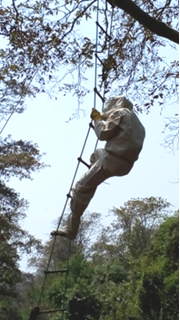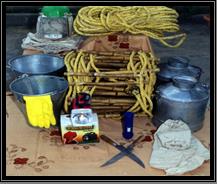Honey and wax is major non timber forest product of India. Amongst the four bee species Apisdorsata, Apis florae, Apisidica and Apisserena indica found in India, Rock Bee– Apis dorsata contributes 70% of annual honey production in India. Honey from Rock Bee is collected from the forest across the country. Unfortunately the tribal honey hunters collect honey for Apis dotsata using very crude and destructive method, which is leading to decline in the honeybee population.
dorsata contributes 70% of annual honey production in India. Honey from Rock Bee is collected from the forest across the country. Unfortunately the tribal honey hunters collect honey for Apis dotsata using very crude and destructive method, which is leading to decline in the honeybee population.
- The dwindling honeybee population hampers the cross pollination of agricultural crops and forest vegetation, which ultimately results in ecological imbalance.
- The use of fire in this traditional method of harvesting honey is also responsible for burning the standing forest wealth.
- The traditional method of smoking/burning, slashing and squeezing the honeycomb for extraction of honey adversely affects the quality and shelf life of honey. These turbid honeys tend to get spoiled very fast thus fetches very low price.
- Dealing with Apisdorsata (Ferrocious honey bee) without safety guards is hazardous and often leads to fatal accidents.
To make honey collection technique nonviolent and eco-friendly “Centre of Science for Villages”, Dattapur, Wardha has evolved a set of appropriate and simple technologies which are non-destructive and non-violent. Technologies evolved and optimized by CSV are elaborated bellow:
Technologies for nonviolent collection of Honey from Rock Bee colonies
To solve technological limitations of traditional methods, CSV evolved a range of technologies which are elaborated below:
Sting Proof Dress
Rock bees are ferocious in nature and they attack in swarm, if they feel that their colony is attacked by an intruder. This natural instinct of rock bees has contributed a great deal in protecting this species from the aggressive nature of man and animal alike.
Protection of the honey hunter from these ferocious bees while handling the honey comb is essential. To achieve this task a sting proof dress is designed which provides full protection to the honey hunters and his helpers. The sting proof dress is made up of double layered thick cotton cloth having a number of air passages. The dress consists of 5 items
- To protect the face of a honey hunter a mask with a plastic wire gauge on front side of the mask. The mask is attached to the jerkin which protects the body of the hunter,
- A pair of hand gloves to protect the palm and hands of the honey hunter. a person,
- A pant to protect body parts below the waist
- Shoe shaped foot cover to protect feet.
- The dress is edged with Velcro strips instead of button linings make it easier to put on and take off the protective dress.
Water Spray
Stinging behaviour of rock bee is initiated by temperature prevailing in the bee colony those results in their collective attack on the victim. To overcome this problem, plain water is sprayed over the rock bee colony due to which the colony temperature comes down which mollifies the bees and plain water restricts bee’s movement as their wings get wet. For this a simple handy water spray is required to spray the bee colony at their nesting spot.
Portable Rope Ladder
Rock bees are accustomed to build their hives at high inaccessible spots on the tree or mountain rocks and hence it becomes difficult to reach and handle them. To overcome this difficulty a light and portable rope ladder made of nylon rope and bamboo steps is designed. Steel wire is interwoven with the nylon rope to increase its strength. This 90 feet long and one foot broad Bamboo ladder weighs about 16 Kg. and can be carried on the bicycle.
To take the ladder to the rock bee spot a small egg shaped lead ball weighing 200 to 250 grams is used. On one end a thin long nylon string is tied to the Lead ball and the other end of the string is tied to a thicker rope attached to the Bamboo ladder. To install the ladder near the rock bee hive spot the stringed lead ball is thrown in a manner that the string crosses over the tree branch where the hive is located it reaches the ground. Now the Nylon string attached to the Led ball is slowly pulled that further pulls the thick nylon rope and the rope ladder is lifted up. Once the ladder is properly installed the long thick rope attached to the bamboo ladder is tightly tied to the tree trunk. Using this ladder a honey hunter can reach close to the bee hive quite comfortably.
Many a times, instead of using the bamboo ladder a thick nylon rope is used. Using the lead ball the rope is thrown across the tree branch. The rope is always very long so that both sides of the nylon rope not only touch the ground but could be safely tied to a tree. One side rope is knotted and the other rope is clear of knots. Climber uses the knotted rope for climbing and clear rope for sliding down the tree. For climbing tall trees simple rope is used as ladder in many different ways.


Honey Processing Device
Processing & Storage of Honey
Initially, the raw-honey procured from honey collectors is stored in the stainless-steel drums of 200 kg capacity. It is then warmed in the Honey Processor Machine at 50-52oC for 6 to 9 hrs depending upon the moisture level of raw honey. This is done by using a special honey processor machine. At this temperature, the osmophylic yeast if present in raw-honey gets killed thus the process of fermentation is arrested. By processing about 2 -3% moisture is eliminated in the form of vapours from the 4 outlets fitted on the top cover of Honey Processor Machine. Thus, the processed honey becomes thick with longer shelflife
raw-honey gets killed thus the process of fermentation is arrested. By processing about 2 -3% moisture is eliminated in the form of vapours from the 4 outlets fitted on the top cover of Honey Processor Machine. Thus, the processed honey becomes thick with longer shelflife
The processed honey is finally filtered through simple bag – filter of 40 µ size and stored in Stainless-Steel drums. It is then packed in the food grade pet jars of 50gm to 1000gm capacity for marketing with the use of various machines like batch printer, aluminum foil packer, shrink plastic (bottlelaminator), etc.
Apis florea (Small bee)
Another species receiving CSV notice is Apis florea, the smallest honey bee. It yields small quantity of honey but is compensated by the abundance of its colonies; moreover it collects honey throughout the year. Due to ease in its handling and abundance of its colonies, it is considered as “poor man’s bee”. The rural women of Vidarbha region are being trained in the scientific method of nurturing Apis florea apiary / hives and extracting honey, as a small scale household industry.
The CSV team has trained around 20000 tribal honey hunters from Maharashtra, Madhya Pradesh, Uttar Pradesh, West Bengal, Bihar, Orissa, Tamilnadu, Karnataka, Himachal Pradesh, Jharkhand, Chhattisgarh and Arunachal Pradesh.
Training:
Till now Bee keeping department has trained around 20,000 tribal honey gatherers from different states of India in non violent extraction of honey. These states include Maharashtra, Madhya Pradesh, Chhattisgarh, Jharkhand, Assam, Orissa, Sudarban, Bengal, Rajasthan, Gujarat, Karnataka, Tamil Nadu, Uttarakhand, Meghalaya, and Arunachal Pradesh.
CSV – Beekeeping Department
Traing of Tribal Honey Gatherers
Year 2022 to 2024
| Sr. No. | State | Department | Numberof Tribal Honey Collectors |
| 1. | Chhattisgarh | Minor Forest Produce Federation (Min.)
11 District Unions (63 Committees)
|
1317
|
| 2. | Arunachal Pradesh | A.P. Forest Cooperation Ltd., Itanagar
4 District- 1 Papunmare 2.Changlang 3. Namsai 4. Lohit |
140 |
| 3. | Jharkhand | 9 Districts
1. Ramgarh, 2. Ranchi, 3. Garhwa, 4. Sahebganj, 5. Jamtara, 6. Hazaribagh, 7. Saraikela, 8. Gumla, 9. Godda Ranchi Forest Department, Palamu (South Division), Khunti Forest Division, Sahebganj Forest Division, Palamu (North Division), Lohardaga Forest Division , Godda Forest Division, Sundar Pahari Forest , Boari Jod Forest Range |
1100 |
